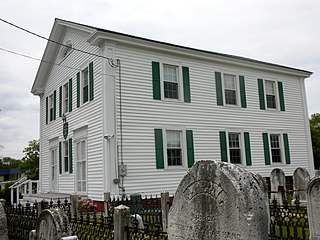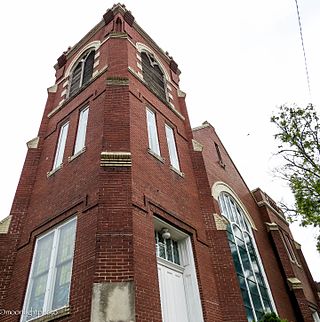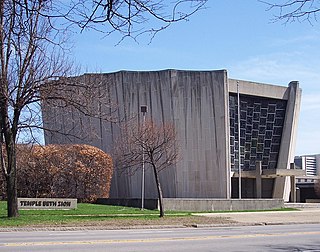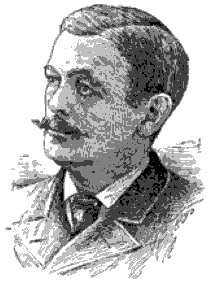Thomas Dixon was a Presbyterian architect born in Wilmington, Delaware and one of the founders of the Baltimore chapter of AIA. He was the father of minister Thomas Freeman Dixon, an 1893 graduate of Princeton Theological Seminary. He partnered with his brother, James M. Dixon, from 1851 until James's death in 1863. In 1871, he partnered with another well-known Baltimore architect Charles L. Carson for some time doing business from their offices at 117 Baltimore Street as Thomas Dixon and Charles L. Carson until sometime before 1877 when the partnership was dissolved. In 1827, he was elected Honorary Academician at the National Academy of Design.

Asbury Methodist Episcopal Church, known now as Asbury United Methodist Church, is a historic church located at Allen, Wicomico County, Maryland. It is a rectangular, gable-front frame structure, with the entrance located in a square bell tower centered on the front. The main block of the building was constructed in 1848 and the tower was added in 1883.

Lovely Lane United Methodist Church, formerly known as First Methodist Episcopal Church and earlier founded as Lovely Lane Chapel, is a historic United Methodist church located at Baltimore, Maryland, United States.

Blessed Trinity Roman Catholic Church Buildings is a historic Romanesque revival Roman Catholic church complex located at Buffalo in Erie County, New York. It is part of the Diocese of Buffalo.

Trinity Episcopal Church is a historic Episcopal church complex located at Buffalo in Erie County, New York. The oldest part of the complex was built in 1869 as the Gothic Revival style Christ Chapel; it was later redesigned in 1913. The main church was constructed in 1884–1886 in the Victorian Gothic style and features stained glass windows designed by John LaFarge and Tiffany studios. The parish house, designed by Cram, Goodhue & Ferguson, was constructed in 1905.

Richmond Avenue Methodist-Episcopal Church, also known as Richmond Avenue United Methodist Church, is a historic Methodist Episcopal Church located at Buffalo in Erie County, New York. It consists of two structures: a rectilinear Chapel structure, which dates to 1885–1891, and a larger Temple structure dating to 1887–1898. Both structures are two and a half stories set on a raised basement story, with two three-story towers. They are built of ashlar Medina sandstone. It is now home to the Upper West Side Arts Center.

Durham Memorial A.M.E. Zion Church, formerly known as St. Luke's A.M.E. Zion Church until the late 1950s, is a historic African Methodist Episcopal Zion Church located at Buffalo in Erie County, New York. It is a brick church constructed in 1920. It is the oldest surviving church associated with the Buffalo A.M.E. Zion congregations.

Parkside West Historic District is a national historic district located at Buffalo in Erie County, New York. The district is architecturally and historically significant for its association with the 1876 Parks and Parkways Plan for the city of Buffalo developed by Frederick Law Olmsted in 1876. It consists of 137 contributing structures developed primarily from 1923 to 1940, as a middle class residential neighborhood. The district largely contains single-family dwellings, built in a variety of popular architectural styles, and located along the irregular and curvilinear street pattern developed by Olmsted. They include homes along Nottingham Terrace and Middlesex Road, and segments of Meadow Road, Lincoln Parkway, Delaware Avenue, and Amherst Street. The district is located to the north of Buffalo's Delaware Park.
Bay Ridge United Methodist Church, originally known as Grace Methodist Episcopal Church, was a historic Methodist church at 7002 Fourth Avenue and Ovington Avenue in Bay Ridge, Brooklyn, New York, New York.

Bloomville Methodist Episcopal Church is a historic Methodist Episcopal church and parsonage of New York state.

Newtonville United Methodist Church is a historic United Methodist church located on Loudon Road at Maxwell Road in Newtonville, Albany County, New York.

Ohio Street Methodist Episcopal Church Complex, also known as Third Avenue Methodist Church and St. Ann Maronite Catholic Church, is a historic Methodist Episcopal church at 1921 Third Avenue in Watervliet, Albany County, New York. It was originally built about 1850 and modified about 1895. The parish house was built about 1880. Both are brick buildings with wood floor and roof framing and stone foundations.

The Architecture of Buffalo, New York, particularly the buildings constructed between the American Civil War and the Great Depression, is said to have created a new, distinctly American form of architecture and to have influenced design throughout the world.

New Asbury Methodist Episcopal Meeting House, now known as Asbury United Methodist Church, is a historic church in Middle Township, Cape May County, New Jersey, about six miles north of Cape May Court House.

Asbury United Methodist Church, originally Highland Park Methodist Episcopal Church, is a historic church on Bailey Avenue in Chattanooga, Tennessee.

Temple Beth Zion is a Reform synagogue located at 805 Delaware Avenue in Buffalo, New York. Founded in 1850, Temple Beth Zion is the largest Jewish congregation in Western New York and one of the oldest and largest Reform congregations in the nation. The circular building features 10 scallop walls, each a symbol of the 10 commandments. The temple contains a Casavant Frères 48-rank, 4000-pipe organ.

Milton Earle Beebe was an American architect who designed numerous buildings in Buffalo, New York, in Fargo, North Dakota, and elsewhere. He designed courthouses "at Warren, Smethport, Cambria, and Huntingdon in Pennsylvania, costing $100,000 each." Several are listed on the National Register of Historic Places. He also designed Early Commercial architecture buildings, residences, churches and public buildings.

Elmwood Historic District–West is a national historic district located at Buffalo, Erie County, New York. The district encompasses 1,971 contributing buildings, 4 contributing structures, and 13 contributing objects in the Elmwood Village neighborhood of Buffalo. It is built around the Buffalo Parks and Parkways system bounded on the north by Delaware Park, Forest Lawn Cemetery, and the former Buffalo State Asylum, on the south by the Allentown Historic District, and on the east by the Elmwood Historic District–East. This predominantly residential district developed between about 1867 and 1941, and includes notable examples of Queen Anne, Shingle Style, Colonial Revival, Tudor Revival, and American Craftsman style architecture. The district contains one of the most intact collections of built resources from turn of the 20th century in the city of Buffalo and western New York State. Located in the district are six previously listed contributing resources including the Richmond Avenue Methodist-Episcopal Church and the Buffalo Tennis and Squash Club. Other notable building include the H.C. Gerber House (1908), the Fred Dullard House (1910), the William H. Scott House (1904), St. John's-Grace Episcopal Church designed by Bertram Grosvenor Goodhue (1925–26), Davidson House (1885), former Jehle Grocery Store and Residence, St. Luke's Episcopal Church, Temple Beth El, Richmond Avenue Church of Christ (now Bryant Parish Condominiums, and Pilgrim-St. Luke's United Church of Christ.

Fargo Estate Historic District is a national historic district located at Buffalo, Erie County, New York. The district encompasses 390 contributing buildings, 1 contributing site, and 2 contributing objects on the Lower West Side of Buffalo. This predominantly residential district developed between about 1850 and 1930, and includes notable examples of Italianate, Queen Anne, Colonial Revival, and American Craftsman style architecture. A 2 1/2-block section of the neighborhood was developed between about 1888 and 1910 on the former "Fargo Estate," the home of William Fargo. Located in the district are the separately listed Engine House No. 2 and Hook and Ladder No. 9 and a section of the Delaware Park-Front Park System. Other notable buildings include the Benedict House, Plymouth Methodist Episcopal Church / now Karpeles Library and Manuscript Museum (1912), and West Side Presbyterian Church / now Iglesia de Cristo Misionera (1882).





















